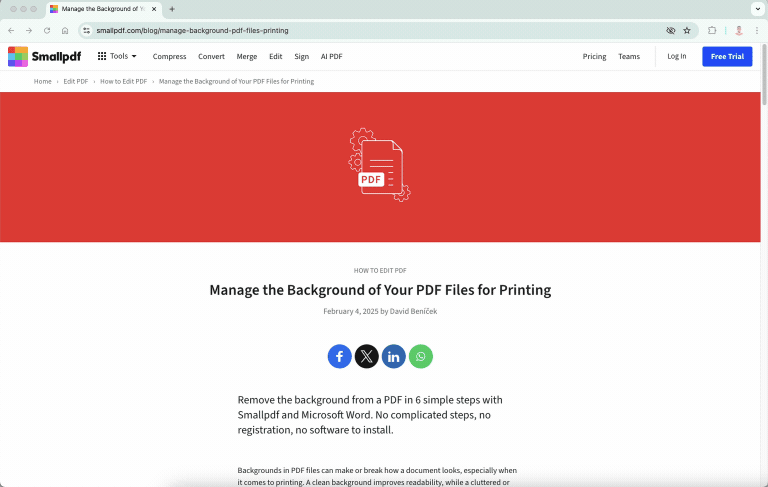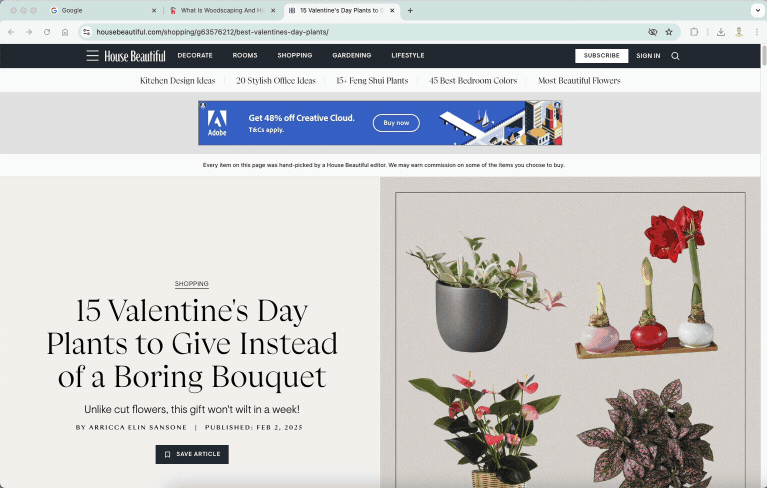
URL to PDF conversion is quick and easy—no extra tools needed. Save any webpage as a PDF straight from your browser in just a few clicks.
Ever found an article, recipe, or set of instructions online and thought, “I’ll need this later”? You could bookmark it, but webpages change or disappear. Saving it as a PDF makes sure you won’t lose it.
There’s always a risk that the formatting won’t be quite right, but once you have a PDF, you can convert it to Word, make changes to the formatting and images in the document, and then save it as a PDF again. We’ll show you how.
Convert a Web Page URL to PDF on Desktop and Mobile
The built-in “Print to PDF” option is your best friend for converting any webpage to PDF. This method works across all major browsers and doesn’t require any additional software or tools.
Desktop Browsers (Chrome, Edge, Firefox, Safari)
Here’s how to save any webpage as a PDF using your desktop browser: 1. Open the webpage in Chrome, Edge, or Firefox. 2. Press Ctrl + P (Windows) or Cmd + P (Mac) to bring up the print menu. 3. In the printer selection, choose “Save as PDF.” 4. Adjust settings if needed (layout, margins, etc). 5. Pick a location, click “Save,” and you’re done!
If you’re a fan of Safari, there is now an “Export as PDF” option under the “File” menu that does just that.

Saving a URL as a PDF in Chrome
Android and iPhone/iPad
The steps are slightly different on your phone, but still simple: 1. Open the page in Chrome (Android) or Safari (iPhone). 2. Tap the “Share” icon, then look for “Print.” 3. In the printer options, select “Save as PDF” or “Print to PDF.” 4. On an iPhone you can just tap the “Share” icon again after selecting “Print.” 5. Tap “Save,” and choose where to store it.

Saving a URL as a PDF on an iPhone
On Android, the PDF usually lands in Downloads. On iPhone, check the Files app under On My iPhone or iCloud Drive.
Fix Layout and Formatting Issues When Saving a Web Page as PDF
If the print formatting isn’t right, try saving the page as HTML first. 1. Right-click anywhere on the page and choose “Save As...” or “Save Page As...” 2. Select “Webpage, Complete” and save it to your computer. 3. Open the saved file in Microsoft Word. 4. Make any formatting tweaks, then Save As a PDF.

Saving a URL as an HTML file first
This method is handy if you need to edit the content before converting it.
Convert Multiple URLs or an Entire Website to PDF
Need to convert more than one webpage? Here are your options for batch conversions and capturing entire websites.
Batch Convert URLs Without Coding
If you don’t want to use an extra tool, you can still save multiple pages efficiently. 1. Open all the pages you need in separate tabs. 2. Press Ctrl + P (Windows) or Cmd + P (Mac) in each tab. 3. Choose “Save as PDF”, then hit “Save.”
Once done, you can use Smallpdf’s Merge PDF to combine the individual files into a single PDF, and even rearrange the pages as necessary. Of course, this method works best if you only have a handful of pages to save, not hundreds or thousands of URLs.
Save an Entire Website to a Single PDF
Some web scrapers are capable of scraping an entire website and saving all pages as PDFs, but this is only useful if all the URLs you are wanting to convert are from the same website.
Developer Options (Command Line and APIs)
There is no easy solution for batch converting a bunch of URLs to PDF. But if you're comfortable working with command line tools, and possibly Python, you can try wkhtmltopdf. No, that’s not a typo—it’s a command line tool that might allow batch URL to PDF conversions.
Add a “Save as PDF” Option to Your Browser or Website
Want to make URL to PDF conversion even faster? You can add permanent shortcuts to your browser or website.
Use a Browser Extension to Convert Web Pages to PDF
Browser extensions can add a one-click “Save as PDF” button to your toolbar, making conversions instant without opening print dialogs. Your best bet is to search for available extensions in your browser of choice, and find the one that works best for you.
Add a “Save to PDF” Link or Bookmarklet
Website owners can add a “Save to PDF” link that visitors can use to instantly convert the current page. This uses a simple JavaScript snippet that triggers the browser’s print-to-PDF function.
Is It Safe to Use URL-to-PDF Tools?
When using online URL-to-PDF converters, security and privacy should be top concerns. Here’s what to look for:
- SSL/TLS encryption during file transfer
- Automatic data deletion after conversion
- Server-side processing without storing content
- GDPR compliance for data protection
- No registration required for basic conversions
What to Do Next With Your PDF (Edit, Compress, Merge)
Once you’ve converted your URL to PDF, you might want to optimize or modify it. Here are the most common next steps:
- Compress your PDF to reduce file size
- Edit the content or add annotations
- Merge multiple PDFs into one document
- Convert to Word for easier editing
- Add password protection for sensitive content
For unlimited access to those and over 30 other PDF tools, start your free trial to Smallpdf.
Converting a URL to PDF: Frequently Asked Questions
How do I turn a URL into a PDF?
Use your browser’s print function (Ctrl+P or Cmd+P) and select “Save as PDF” from the printer options. This works on any webpage in any browser.
How do I download a PDF from a URL?
If the URL already points to a PDF file, right-click the link and choose “Save link as” or simply click the link to open and download it directly.
How can I convert multiple URLs into separate PDFs?
If it’s just a handful of pages, opening each one in a new tab and using the “Save as PDF” option in the print dialog is a simple enough solution. If you have a long list of URLs you want to convert to PDF, wkhtmltopdf might be a better option, though it does require some technical skill to use.
Can I save a webpage’s links as PDFs too?
Yes, but it depends on how many links you’re dealing with. If you just need a couple of linked pages, you can open them manually and print them as PDFs like normal. If you want to grab every link on a webpage, tools like All Links Downloader could be useful. Just keep in mind that this will download each linked page as HTML, so you would still need to convert to PDF later.
Converting a single URL to PDF is easy enough for anyone to do, and combined with Smallpdf, you can then edit the content, convert the PDF, or even merge multiple PDFs into a single file. It’s nice to know you’ve got options.



